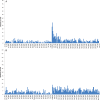Admission to psychiatric hospital in the early and late postpartum periods: Scottish national linkage study
- PMID: 26733566
- PMCID: PMC4716159
- DOI: 10.1136/bmjopen-2015-008758
Admission to psychiatric hospital in the early and late postpartum periods: Scottish national linkage study
Abstract
Objective: To describe weekly admission rates for affective and non-affective psychosis, major depression and other psychiatric disorders in the early and late postpartum periods. To assess the impact of socioeconomic status, age and parity on admission rates.
Methods: Scottish maternity records were linked to psychiatric hospital admissions. 3290 pregnancy-related psychiatric admissions were assessed. Weekly admission rates were calculated for the pregnancy period, early postpartum period (6 weeks after birth) and late postpartum period (up to 2 years after birth), and compared with pre-pregnancy rates (up to 2 years before pregnancy). Admission rates were generated by calculating the total number of admissions for each time period divided by the number of weeks in the period. Incidence rate ratios (IRRs) were generated for each time period, using deprivation, age, parity and record of previous psychiatric hospital care-adjusted Poisson regression models.
Results: Women from more deprived social quintiles accounted for the largest proportion of admissions across all time periods. Compared with pre-pregnancy period, admission rates fell during pregnancy, increased markedly during the early postpartum period, and remained elevated for 2 years after childbirth. Within the most affluent quintile, admission IRRs were higher in the early postpartum period (IRR=1.29, 95% CI 1.02 to 1.59) than in the late postpartum period (IRR=0.87, 95% CI 0.74 to 0.98). For the late postpartum period, there was a positive association between higher maternal age and admission IRRs (ages 20-35 years, IRR=1.35, 95% CI 1.16 to 1.54 and age>40 years IRR=1.72, 95% CI 1.41 to 2.09).
Conclusions: Rates of psychiatric admission fell during pregnancy and increased in the early postpartum period (particularly during the first 2 weeks after birth), and remained elevated above baseline during the 2-year late postpartum period. An understanding of how social deprivation, age and parity might influence risk of psychiatric admission at different time points could help to target perinatal mental health services more effectively.
Keywords: MENTAL HEALTH.
Published by the BMJ Publishing Group Limited. For permission to use (where not already granted under a licence) please go to http://www.bmj.com/company/products-services/rights-and-licensing/
Figures




References
MeSH terms
LinkOut - more resources
Full Text Sources
Other Literature Sources
Medical
